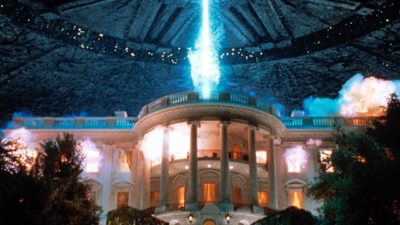The summer of 1996 the movie Independence Day (ID4) was everywhere. It’s hard to understand now with how much pop-culture is fragmented, but 20 years ago that movie was ubiquitous on TV commercials, on the covers of magazines and in print ads as well. Even though back then it took a lot to get me to go out to see a movie I remember being particularly excited about ID4. In fact, now that I think about it, between the years 1994 and 1997 the ONLY movie I saw in the theater was ID4.
But why? Why was ID4 THE movie to see that year?

Was it because of actor Will Smith? Maybe, but at the time Smith was more known as a guy on TV who in 1996 was just on the verge of becoming a world-wide mega-star.
Was it because the movie was the “hip” flick of the year? Again, maybe. But a movie really can’t be “hip” until people see it. And everyone was excited and talking about ID4 for months before the release.
I think the reason ID4 was so big was because it was the first disaster movie to be released in the digital age.
Always before with disaster movies all the special effects were practical — done with models and other in-camera effects. But ID4 would be the first big-budget movie to use the then relatively new computer special effects to show all the damage and destruction that comes with a disaster flick on a grand scale. Even the best movies using practical special effects that try and show a huge expanse of disaster can come off looking cheap and cheesy. With those movies, wide vistas usually have to be done with large static matte paintings along with miniature models and various in-camera trickery.

And those are for the big budget movies. For the many large scale disaster movies that didn’t have a decent budget things look much worse. Miniature buildings don’t look like real buildings. Cheap blue-screen backgrounds look like cheap blue-screen backgrounds. And, worst of all, good special effects shots get used over and over again or good special effects shots from other movies are recycled into the cruddy ones.
But most of these problems disappear in the digital realm. What’s very hard to do practically is relatively easy to do digitally. And that’s what I think we were looking forward to the most with ID4 the summer of 1996. We were finally going to see just what the end of the world might look like in all its realistic glory. Or at least as “realistic” as gigantic alien spaceships zapping major metropolitan areas can be.
When I saw ID4 I remember being particularly impressed. I adored the movie, how it kept me on the edge of my seat and I loved how everything looked. In fact, I remember buying the ID4 movie magazine that fall and taking it into a college computer art and design class and looking at the pictures with classmates trying to figure out how all the special effects were done.
 Later on in 1996 when ID4 was being released on VHS the excitement over that movie coming out on home video was palpable too. I remember standing in the lobby of a OnCue and watching the VHS commercial/trailer for ID4 over and over and over again. I bought ID4 when it came out on VHS and even “upgraded” my purchase years later by buying a bootleg VHS director’s cut of the movie dubbed from Laserdisc.
Later on in 1996 when ID4 was being released on VHS the excitement over that movie coming out on home video was palpable too. I remember standing in the lobby of a OnCue and watching the VHS commercial/trailer for ID4 over and over and over again. I bought ID4 when it came out on VHS and even “upgraded” my purchase years later by buying a bootleg VHS director’s cut of the movie dubbed from Laserdisc.
The ID4 disaster flick was so successful that it would later spawn a flock of other disaster movies in the late 1990s as well. From Volcano and Dante’s Peak (both 1997) to Deep Impact and Armageddon (both 1998) no part of the Earth was safe from destruction. And even the creators of ID4 tried their hand at another disaster film a few years later with Godzilla also in 1998.
Looking back now I’d say that ID4 is an enjoyable movie with some problems. It’s not one of those films that stands up to multiple viewings. It’s fun the first time, but not so much later after the holes become apparent. I can only hope the Independence Day sequel, titled Independence Day: Resurgence, out almost exactly 20 years after the original is at least as fun as the first film.
